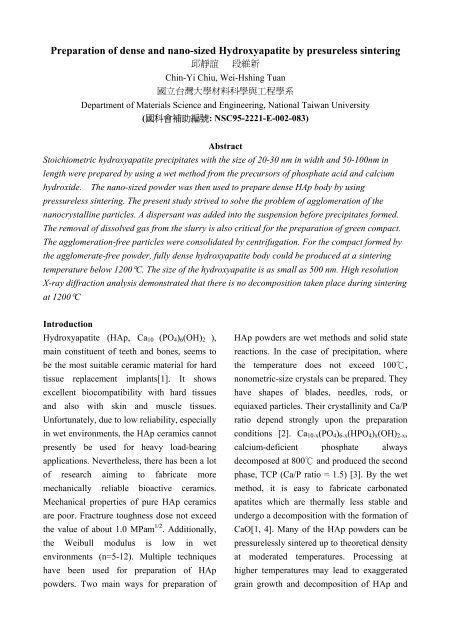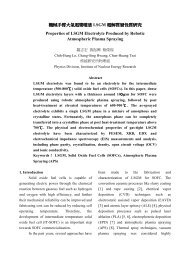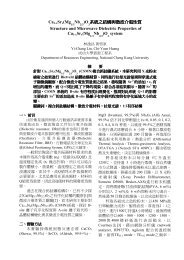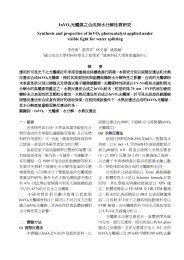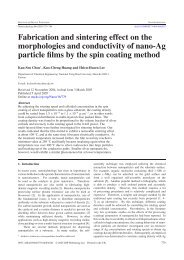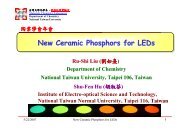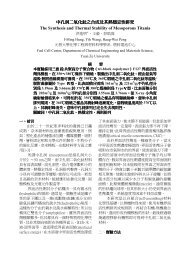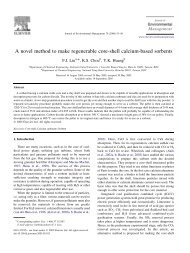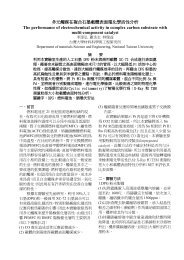Preparation of dense and nano-sized Hydroxyapatite by presureless ...
Preparation of dense and nano-sized Hydroxyapatite by presureless ...
Preparation of dense and nano-sized Hydroxyapatite by presureless ...
You also want an ePaper? Increase the reach of your titles
YUMPU automatically turns print PDFs into web optimized ePapers that Google loves.
<strong>Preparation</strong> <strong>of</strong> <strong>dense</strong> <strong>and</strong> <strong>nano</strong>-<strong>sized</strong> <strong>Hydroxyapatite</strong> <strong>by</strong> <strong>presureless</strong> sintering<br />
邱靜誼 段維新<br />
Chin-Yi Chiu, Wei-Hshing Tuan<br />
國立台灣大學材料科學與工程學系<br />
Department <strong>of</strong> Materials Science <strong>and</strong> Engineering, National Taiwan University<br />
(國科會補助編號: NSC95-2221-E-002-083)<br />
Abstract<br />
Stoichiometric hydroxyapatite precipitates with the size <strong>of</strong> 20-30 nm in width <strong>and</strong> 50-100nm in<br />
length were prepared <strong>by</strong> using a wet method from the precursors <strong>of</strong> phosphate acid <strong>and</strong> calcium<br />
hydroxide. The <strong>nano</strong>-<strong>sized</strong> powder was then used to prepare <strong>dense</strong> HAp body <strong>by</strong> using<br />
pressureless sintering. The present study strived to solve the problem <strong>of</strong> agglomeration <strong>of</strong> the<br />
<strong>nano</strong>crystalline particles. A dispersant was added into the suspension before precipitates formed.<br />
The removal <strong>of</strong> dissolved gas from the slurry is also critical for the preparation <strong>of</strong> green compact.<br />
The agglomeration-free particles were consolidated <strong>by</strong> centrifugation. For the compact formed <strong>by</strong><br />
the agglomerate-free powder, fully <strong>dense</strong> hydroxyapatite body could be produced at a sintering<br />
temperature below 1200°C. The size <strong>of</strong> the hydroxyapatite is as small as 500 nm. High resolution<br />
X-ray diffraction analysis demonstrated that there is no decomposition taken place during sintering<br />
at 1200°C<br />
Introduction<br />
<strong>Hydroxyapatite</strong> (HAp, Ca10 (PO4)6(OH)2 ),<br />
main constituent <strong>of</strong> teeth <strong>and</strong> bones, seems to<br />
be the most suitable ceramic material for hard<br />
tissue replacement implants[1]. It shows<br />
excellent biocompatibility with hard tissues<br />
<strong>and</strong> also with skin <strong>and</strong> muscle tissues.<br />
Unfortunately, due to low reliability, especially<br />
in wet environments, the HAp ceramics cannot<br />
presently be used for heavy load-bearing<br />
applications. Nevertheless, there has been a lot<br />
<strong>of</strong> research aiming to fabricate more<br />
mechanically reliable bioactive ceramics.<br />
Mechanical properties <strong>of</strong> pure HAp ceramics<br />
are poor. Fractrure toughness dose not exceed<br />
the value <strong>of</strong> about 1.0 MPam 1/2 . Additionally,<br />
the Weibull modulus is low in wet<br />
environments (n=5-12). Multiple techniques<br />
have been used for preparation <strong>of</strong> HAp<br />
powders. Two main ways for preparation <strong>of</strong><br />
HAp powders are wet methods <strong>and</strong> solid state<br />
reactions. In the case <strong>of</strong> precipitation, where<br />
the temperature does not exceed 100℃,<br />
nonometric-size crystals can be prepared. They<br />
have shapes <strong>of</strong> blades, needles, rods, or<br />
equiaxed particles. Their crystallinity <strong>and</strong> Ca/P<br />
ratio depend strongly upon the preparation<br />
conditions [2]. Ca10-x(PO4)6-x(HPO4)x(OH)2-x,<br />
calcium-deficient phosphate always<br />
decomposed at 800℃ <strong>and</strong> produced the second<br />
phase, TCP (Ca/P ratio = 1.5) [3]. By the wet<br />
method, it is easy to fabricate carbonated<br />
apatites which are thermally less stable <strong>and</strong><br />
undergo a decomposition with the formation <strong>of</strong><br />
CaO[1, 4]. Many <strong>of</strong> the HAp powders can be<br />
pressurelessly sintered up to theoretical density<br />
at moderated temperatures. Processing at<br />
higher temperatures may lead to exaggerated<br />
grain growth <strong>and</strong> decomposition <strong>of</strong> HAp <strong>and</strong>
subsequently to strength degradation. Hot<br />
pressing, hot isostatic pressing or HIP<br />
postsintering make it possible to decrease the<br />
temperature <strong>of</strong> the densification process,<br />
decrease the grain size <strong>and</strong> achieve higher<br />
densities. This leads to finer microstructure,<br />
higher thermal stability <strong>of</strong> HAp, <strong>and</strong><br />
subsequently better mechanical properties [2].<br />
Experiment procedure<br />
500ml <strong>of</strong> 0.3M phosphate acid (99%, MERCK,<br />
Germany) solution was added into the stirred<br />
calcium hydroxide (98+ %, ACROS<br />
ORGANICS, USA) suspension with addition<br />
<strong>of</strong> a dispersant in a dropwise manner. The<br />
precipitate in the suspension with the pH value<br />
7~7.5, ammonia (28%, Nacalai Tesque, Japan)<br />
was used to control it, was then aged for 20<br />
hours at 80℃. After ageing, the slurry with the<br />
particles that did not set after 20 hours was<br />
decanted into vessels. The dissolved gas was<br />
removed from the slurry <strong>by</strong> a vacuum pump<br />
(up to 5 x 10 -4 torr, ULVAC, Japan). The<br />
vessels was put in a centrifuge (KUBOTA<br />
2010, Japan) <strong>and</strong> spun at 1000rpm for 30min,<br />
3000rpm for 20min <strong>and</strong> 4000rpm for 10 min.<br />
The supernatant aqueous solution was removed.<br />
The deposited kept in the vessel <strong>and</strong> dried at<br />
the room temperature <strong>and</strong> dried at 100 ℃ in an<br />
oven for 24 hours. The specimens were<br />
sintered <strong>by</strong> pressureless sintering in air. The<br />
heating <strong>and</strong> cooling rate was 5 ℃ /min <strong>and</strong><br />
sintering temperatures were 1000 ℃ , 1100 ℃<br />
<strong>and</strong> 1200 ℃ . Different dwelling times at each<br />
sintering temperature were 1 minute, 2 hours<br />
<strong>and</strong> 20 hours. The phase identification <strong>of</strong> the<br />
sintered HAp specimens studied <strong>by</strong> X-ray<br />
scattering, 8Kev, λ=1.54975 °A, 17B1 beam<br />
line at National Synchrotron Radiation<br />
Research center (NSRRC) in Taiwan. Fourier<br />
transform infrared (FTIR) spectra were<br />
obtained <strong>by</strong> FT/IR-410 series spectrometer<br />
(JASCO, Germany). The particle size <strong>of</strong> the<br />
HAp precipitates was determined with a laser<br />
particle size analyzer (Master2000, Malvern<br />
Co., USA). Distilled water was used to be a<br />
dispersed medium. The green compact was<br />
pre-heated to 600 ℃ for 1 hour<br />
to get<br />
non-sintered HAp specimens. By thermal<br />
dilatometer, the pre-heated sample was heated<br />
to 1300℃ for 1 hr at a heating rate <strong>of</strong> 5 ℃ /min<br />
Fracture microstructures <strong>of</strong> the pre-heated<br />
green compact <strong>and</strong> the HAp specimens after<br />
sintering were observed <strong>by</strong> FESEM (LEO<br />
1530 Gemini, Zeiss/LEO, Germany). The<br />
apparent density <strong>of</strong> sintered materials was<br />
measured <strong>by</strong> the Archimedes technique in<br />
water. Pore size distribution <strong>of</strong> the HAP green<br />
compact was determined <strong>by</strong> Mercury<br />
Porosimeter (Micromeritics, Autopore 9520,<br />
USA). To obtain the mean grain size <strong>of</strong><br />
sintered HAp, the specimens were ground <strong>and</strong><br />
polished to 0.05um finish with Al2O3 particles.<br />
The mirror-polished specimens were etched<br />
with 0.1M <strong>of</strong> acetic acid for 2~2.5min. The<br />
mean grain size was determined with the SEM<br />
micrographs <strong>and</strong> calculated <strong>by</strong> multiplying<br />
1.56 the average linear intercept length <strong>of</strong> at<br />
least 300 grains. At lower density <strong>of</strong> sintered<br />
HAp, the mean grain size was obtained on the<br />
fracture surface.<br />
Results <strong>and</strong> discussion<br />
The HAp specimen prepared <strong>by</strong> the colloidal<br />
process with addition <strong>of</strong> a dispersant display<br />
the most homogeneous microstructures. Its<br />
agglomerated size is~200nm, much smaller<br />
than that <strong>of</strong> the die-pressing specimen. The<br />
dispersed specimen also shows a homogeneous<br />
pore size distribution. See Fig. 1 <strong>and</strong> Fig. 2.<br />
Each pore size requires a certain temperature
for its elimination, see Fig. 3. The reduction <strong>of</strong><br />
agglomeration lowers the sintering temperature<br />
<strong>of</strong> the HAp. See Fig. 4, as the specimens<br />
sintered at 1100 ℃ for 2 hrs, the relative<br />
density <strong>of</strong> the dispersed sample reaches about<br />
90%, but that <strong>of</strong> the die-pressing sample is<br />
below 60%. The reduction <strong>of</strong> agglomerated<br />
size also reduces the grain growth in the final<br />
stage <strong>of</strong> sintering. The grain size <strong>of</strong> the<br />
die-pressing (at 1300 ℃ for 2hrs) <strong>and</strong> the<br />
dispersed specimens (at 1200 ℃ for 2 hrs) with<br />
the similar <strong>dense</strong> microstructures is 2µm <strong>and</strong><br />
0.7µm, respectively. Reducing the<br />
agglomeration <strong>of</strong> fine particles is a prerequisite<br />
for reaching <strong>dense</strong> microstructure without<br />
final-stage grain growth <strong>by</strong> two-step sintering.<br />
In this study, we reduce the agglomerate size<br />
<strong>by</strong> the colloidal process with addition <strong>of</strong> a<br />
dispersant before the formation <strong>of</strong> the HAp<br />
precipitates, that is, before the formation <strong>of</strong> the<br />
agglomerates. Subsequently, two-step sintering<br />
is applied to obtain the <strong>dense</strong> compact without<br />
the final-stage grain growth. The dispersed<br />
specimen after sintering to 1200℃ <strong>and</strong> then<br />
sintering at 1100℃ for 20 hrs displays its<br />
relative density up to 95% <strong>and</strong> grain size 380<br />
nm, see Fig. 5. The specimen increases its<br />
density up to 4% without any grain growth in<br />
the second stage sintering.<br />
Fig. 1. Particle size distributions <strong>of</strong> the HAp<br />
powders treated with various processes.<br />
Fig. 2. Pore size distributions <strong>of</strong> the HAp<br />
specimens prepared <strong>by</strong> various processes.<br />
Fig. 3. Shrinkage rate curves for the HAp<br />
specimens prepared <strong>by</strong> various processes as a<br />
function <strong>of</strong> temperature.<br />
Fig. 4. Grain size <strong>of</strong> the sintered HAp prepared<br />
<strong>by</strong> various processes <strong>and</strong> sintering pr<strong>of</strong>ile as a<br />
function <strong>of</strong> relative density.
Fig. 5. Microstructure <strong>of</strong> two-step sintered<br />
HAp after sintering to 1200℃ <strong>and</strong> at 1100℃<br />
for 20hrs.<br />
Conclusions<br />
The precipitates <strong>by</strong> colloidal process with the<br />
addition <strong>of</strong> a dispersant are well dispersed<br />
although some residual agglomerates still<br />
existed. By the addition <strong>of</strong> a dispersant in the<br />
suspension, the serious agglomeration <strong>of</strong><br />
<strong>nano</strong>-size particles are relieved, <strong>and</strong> most pores<br />
in the green body are with the same size. The<br />
sintering temperature for the dispersed samples<br />
was lower with respect to the agglomerated<br />
samples. Besides, the two-step sintering<br />
technique has reduced the grain growth <strong>of</strong><br />
<strong>nano</strong>-size grains <strong>and</strong> the <strong>dense</strong> HAp specimen<br />
with the grain size smaller than 400nm was<br />
produced.<br />
Reference<br />
[1] T. Kokubo, H.-M. Kim, M. Kawashita,<br />
Novel bioactive materials with different<br />
mechanical properties, Biomaterials 24 (2003)<br />
2161–2175.<br />
[2] W. Suchanek, M.Yoshimura, Processing<br />
<strong>and</strong> properties <strong>of</strong> hydroxyapatite-based<br />
biomaterials for use as hard tissue replacement<br />
implant, J. Mater. Res. 13 (1998) 94–117.<br />
[3] S. Raynaud, E. Champion, D.<br />
Bernache-Assollant, Calcium phosphate apatite<br />
with variable Ca/P atomic ratioⅡCalcination<br />
<strong>and</strong> sintering. Biomaterials 23 (2002)<br />
1073-1080.<br />
[4] A. Slosarczyka, Z. Paszkiewicza, C.<br />
Paluszkiewicza, FTIR <strong>and</strong> XRD evaluation <strong>of</strong><br />
carbonated hydroxyapatite powders synthe<strong>sized</strong><br />
<strong>by</strong> wet methods. Journal <strong>of</strong> Molecular<br />
Structure 744-747(2005)657-661.<br />
[5] I.-Wei Chen & X.-H. Wang, Sintering<br />
<strong>dense</strong> <strong>nano</strong>crystalline ceramics without<br />
final-stage grain growth, Nature 404 9 March<br />
(2000) 168-171.<br />
[6] M. J. Mayer, Processing <strong>of</strong> <strong>nano</strong>crystalline<br />
ceramics from ultrafine particles, International<br />
Materials Review 1996 vol.41 No. 3.<br />
[7] Joanna R Groza, Nanosintering,<br />
NanoStructured Materials, 12 (1999) 987-992.<br />
[8] E. L<strong>and</strong>i, A. <strong>and</strong> etc, Densification<br />
behavior <strong>and</strong> mechanisms <strong>of</strong> synthetic<br />
hydroxyapatites, Journal <strong>of</strong> European<br />
Ceramics Society 20 (2000) 2377-2387.<br />
[9] Jingxian Zhang <strong>and</strong> etc, Colloidal<br />
processing <strong>and</strong> sintering <strong>of</strong> hydroxyapatite,<br />
Materials Chemistry <strong>and</strong> Physics 101(2007)<br />
69-76.


